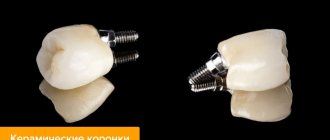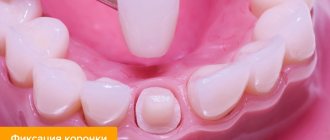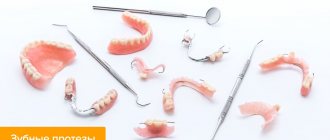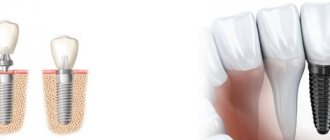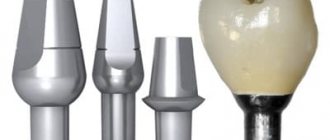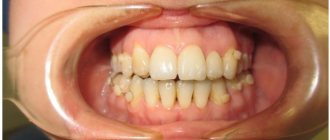High-tech fixed dentures supported by implants are the latest technology for replacing teeth after extraction or in case of serious defects of the jaw apparatus. Experts call this technology the best alternative to removable prosthetics and classic bridge structures.
The implantation method involves installing an artificial root into the jaw. Crown prostheses are put on him. The supporting part, which is implanted into the jaw tissue, is made of titanium, an inert biocompatible material. This allows the products to fuse with the bone without being rejected by the body.
The design is multicomponent and consists of several elements:
- An implant that takes on the function of the root;
- Abutment;
- A crown that is made of metal ceramics or zirconium dioxide.
Indications
Dental prosthetics using implant systems is used for partial or complete edentia. The technique allows the patient to restore the functions of the jaw apparatus and the aesthetics of the smile.
Dental implants are installed after surgical removal of teeth, household or sports injuries to the jaw. The method is recommended for people with serious congenital and acquired defects of the dental system.
This type of denture is optimal for replacing front teeth, which are visible during communication and eating. The products look natural, so the consequences of surgical intervention are invisible to patients and the people around them.
Caring for removable dentures
To maintain the functionality and presentable appearance of your removable denture for a long time, simple daily care is necessary. Dentures do not require special care. There is absolutely no need to take them off at night. For the first couple of months, dentures should be kept in a damp environment. Fresh plastic can continue to release monomer for a long time. In air, this process can lead to the formation of whitish stains inside the plastic, and the prosthesis takes on a somewhat “marbled” appearance. This does not happen in water. Therefore, at first the prosthesis should be in the mouth, or in a glass of water.
We recommend brushing your dentures at least twice a day, and preferably after each meal, or before bed, using the same movements as you would your teeth, using a soft toothbrush and toothpaste. All surfaces of the denture are important, but special attention should be paid to the inner surface of the denture, adjacent to the gum.
There are also special solutions for caring for dentures (and special tablets for their manufacture). The prosthesis is placed in it once a day for 15 minutes to rid the surface of the structure of germs, dyes, food debris and unpleasant odors - this way the prosthesis receives more durable protection. Even more serious tablets with a bioformula are used only once a week, but this is enough - penetrating into all the cracks, such a solution removes any plaque without causing harm to the materials from which the prosthesis is made.
Contraindications
All methods of fixed prosthetics have a number of limitations, and implantation is no exception. This method of restoration has a sufficient number of contraindications. Installation of implants is prohibited in the presence of a number of diseases and conditions:
- pregnancy;
- alcohol or drug addiction;
- bone diseases;
- mental disorders and acute stress;
- inability to use anesthetics due to allergies to drugs;
- HIV infection;
- oncological processes;
- severe forms of diabetes mellitus, acute cardiovascular diseases, disorders of the immune system.
In addition to general restrictions, there are temporary ones. Implant-supported crowns are not installed on children and adolescents. The formation of their skeleton, including their facial bones, has not yet been completed, so there is a risk of deformation.
Often, implantation has to be abandoned for a while due to poor oral health. Before starting work, the dentist eliminates carious lesions, inflammation and gum disease, and carries out professional hygiene.
What is dental implantation
Dental implantation is a surgical operation whose purpose is osseointegration, i.e., implantation of a titanium alloy pin (implant) into the jaw bone tissue. The pin performs the functions of a tooth root - it becomes a support on which a crown is fixed, imitating the shape of a natural tooth. It is attached to the implant using an abutment (a threaded fastener). Titanium is highly biocompatible and hypoallergenic, so it is not rejected by the body. The survival rate of titanium roots is 99%. The operation to fix the implants is performed by a dental surgeon who has undergone special training in a dental clinic.
Advantages
The advantage of the technique is the complete restoration of the integrity of the dentition, regardless of the number of lost elements. There are methods of prosthetics on implants that are used for complete edentia. Fixing the structures into the jaw will ensure reliability and create a load on the bones. This prevents the development of atrophic processes.
Implantation technology allows you to do without grinding and depulping adjacent teeth. The progressive technique is designed to preserve the health of natural tissues. Dentures with artificial roots are very durable and have impeccable aesthetics. Products last 20-25 years.
To correct the bite, specialists have developed mini-implants. These products have a reduced diameter. They are used for fastening orthopedic and orthodontic devices and guarantee reliable fixation.
Get a consultation
We will answer all your questions before visiting the clinic!
+7
Online registration
Temporary crown for implant
Some patients are interested in: “Temporary crown on an implant - why is it installed?” In fact, fixing a plastic structure is not required in all situations. Such a need arises only in the process of performing a one-stage procedure with immediate loading.
Most often, temporary crowns are fixed to implants during the period of restoration of teeth in the anterior region. Also, the use of these prostheses is due to the specific structure of dental implants used for a one-stage technique. In addition, they have a one-piece design with an adapter. Another feature is the presence of a special thread, which allows screwing into the bone and eliminates the need to create a hole using a drill. All this contributes to more reliable fastening of implants and ensures their increased resistance to the weight of the installed temporary structure and instant chewing load.
Which crown is best to put on an implant?
One of the key questions that worries patients is: “What to prefer: a zirconium or metal-ceramic crown?” Of course, the most budget-friendly option would be to fix metal-ceramic prostheses. There is virtually no chance of chipping. This allows us to judge the choice of this material for restoring teeth in the chewing area.
However, if you require a crown on an implant of a front tooth, when choosing a prosthesis, you should take into account the transparency of nearby units. So, with increased transparency of the enamel, it is advisable to fix a ceramic crown on the installed implant. If the light transmittance of the teeth is insignificant, it is quite possible to install a metal-ceramic structure. But to achieve the ideal prosthetic effect and obtain absolutely natural-looking and highly durable crowns, preference should be given to the glass-ceramic material e.max. Despite the high cost of such products, this is an ideal option for restoring the aesthetic and functional characteristics of teeth.
Flaws
Implantation is the most progressive method of restoration. Its price becomes more affordable every year, but such treatment requires more investment compared to classic options.
Due to the complexity and traumatic nature of the procedure, it has many limitations. During the rehabilitation period after surgery, a person must follow a number of rules to avoid the artificial root falling out or becoming infected.
In some cases, implantation is performed in several stages, which will increase the duration of treatment.
First way
An analogy can be drawn with clothing: fixation occurs when one element “snaps” inside another, as in the case of buttons.
So, the upper part of the implant has a spherical shape, elements in the form of “reciprocal grooves” are mounted into the prosthesis, corresponding in shape and size to the spherical element of the implant (so that the spherical part is inside); Thus, one element is put on another element, and this is how the prosthesis is fixed.
Timing of prosthetics on implants
The duration of treatment depends on the chosen implantation technology. It can be single-stage or multi-stage. The express method allows you to immediately install dentures after surgical removal. The pin is implanted into the postoperative socket and a crown is put on.
The classic method is performed in two stages. After sanitation, the doctor deepens an artificial root into the jaw and places sutures on the gum to heal the wound. If the tooth is on the smile line, a temporary prosthesis is installed. The sutures are removed after 7-10 days, and a permanent crown is placed within three to six months, when the root fuses with the jaw.
The treatment process goes as follows:
Initial consultation, examination, modeling
Collecting information about the patient’s health status - blood tests and computed tomography of the oral cavity. Before the operation, an individual prosthesis is modeled for the patient in a special program. The doctor enters the patient's X-ray, sets the parameters for installing the implants, and evaluates the result. Therefore, already at the consultation stage, all risks associated with possible rejection of artificial roots can be calculated.
Implant installation surgery and prosthetics
Gone are the days when implantation took many months. Today, tooth extraction and insertion of artificial roots occur simultaneously. If, during the “Teeth in One Day” method of drawing up a treatment plan, it was planned to remove teeth to sanitize the oral cavity, then an implant is immediately placed in the hole from the extracted tooth. There is also no need to cut the gum, which eliminates severe swelling the next day after the procedure. The advantage of the one-step prosthetics technique is the fixation of the adaptive prosthesis immediately after installation of the implants. A frame in the form of a plastic gum allows you to level the surface of the jaw in case of bone atrophy, and also solves the aesthetic problem. Teeth without this design will look unnaturally long. The guaranteed service life ranges from six months to 3 years.
Follow-up with calibration of the temporary prosthesis and replacement with a permanent one
In the next six months, the patient will come to the clinic for relining of a fixed prosthesis, since the bone relief will change during the tissue healing process. After this period, or at the request of the patient, it is possible to replace the temporary adaptation with a permanent prosthesis, the service life of which begins from 5 years.
Immediate loading of the implant
The Immediate Load one-stage express technique is used to replace one or more units of the dentition. After surgical removal, the artificial root is screwed into the bone into the deep basal layers and a denture made of lightweight metal-plastic is fixed. It creates a chewing load on the jaw apparatus, prevents atrophic processes that lead to a decrease in the volume of bone tissue.
The service life of an adaptive denture is up to three years. In the future, the product can be replaced with durable metal ceramics or zirconium dioxide.
Types of clasp dentures
Let's look at the different types of clasp prosthetics used in the Dentalika clinic.
The clasp clasp prosthesis is held in place using hooks (clasps) that tightly cover the tooth but do not harm the enamel (see picture):
Clasp prosthesis with locking fixation - the fixing element is hidden inside the prosthesis, and therefore, even with a wide smile, the removable structure is absolutely invisible:
Clasp prosthesis on telescopic crowns - is held on the tooth using a crown consisting of two parts: the first part is a removable metal-ceramic crown, the second is a metal cap with parallel walls, cemented to the tooth. The crowns fit one on top of the other, tightly fixing, the prosthesis is comfortable and is not perceived as removable.
Caring for a clasp prosthesis is simple: in the evening you need to remove and clean the prosthesis. You don’t have to remove the prosthesis at night, which is quite comfortable psychologically.
The clasp denture is a technologically complex design, which leads to the need for mandatory periodic monitoring by your attending physician in order to monitor the inevitable “gum shrinkage” under the prosthetic bed (to avoid the appearance of voids there) and the load on the supporting teeth. If necessary, relining (layering of plastic) of the prosthesis is carried out.
We recommend that our patients pay attention to full and partial removable dentures ACRI-FRI (see pictures) and Vertex , which have proven themselves in the practice of our clinic.
Prosthetics after 3-6 months
Implantologists call this technology classical. It provides for a significant separation in time between stages of treatment. After installing the titanium support, the doctor waits for osseointegration to complete. The process is individual for each person and takes several months. The second stage of work is fixing the gum former and directly attaching the crown to the abutment.
If there is a deficiency in jawbone volume, it is augmented using synthetic material.
Fixing creams
It is especially worth noting that in some cases, the system of prosthetic care products includes fixing agents, especially when the prosthesis has just been installed and one is getting used to it. This helps solve a number of physiological and psychological problems. Retention devices also give a person confidence that the denture will not fall out of the mouth. Fixation means are selected depending on the individual characteristics of the patient.
Doctor - dentist - orthopedist of the Dentalika clinic Belov S.A.
Dear Colleagues! When copying information, placing a link to the source site is mandatory!
Stages of prosthetics
The event using classical technology includes the following procedures:
- diagnostics of the oral cavity (orthopantomogram, 3D image), general tests;
- sanitation of the oral cavity;
- metal root fastening;
- installation of a gum former;
- fixation of the crown.
The procedure is performed under local anesthesia. It takes 30-40 minutes to install one rod. During the rehabilitation period, the patient is prescribed painkillers and antibiotics.
What does the cost consist of?
At each stage, a specialist needs to carry out difficult work:
Preparation for surgery requires the doctor to have precise knowledge of the anatomical structure of the jaw. In addition, the cost of treatment includes computed tomography and other procedures to obtain the necessary information about the clinical situation.
Implantation is a complex process that requires certain skills. A good implantologist is worth his weight in gold - only a trained specialist will be able to install implants that will last for the rest of your life. Such services cannot be cheap. The most advanced implantation technologies require high costs, but guarantee excellent results.
Installation of prostheses. The cost will largely depend on the material chosen for the prosthesis. Metal, metal ceramics and zirconium dioxide have different costs.
How to choose between implants from different manufacturers?
The implantation systems market is represented by products from numerous brands. Specialists from leading clinics use designs from top manufacturers from Israel, Germany, the USA, Korea, and Switzerland in their work.
Products from Swiss and German brands fall into the luxury and premium categories. The advantage of the systems is the maximum survival rate, which exceeds 99%. Korean and Israeli companies produce models in the middle and budget price range. This has ensured that they are widely in demand among dentists and their clients.
